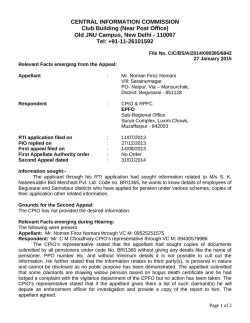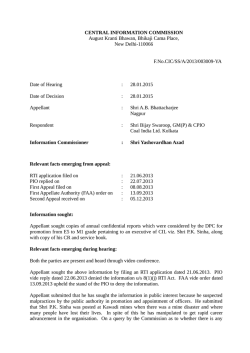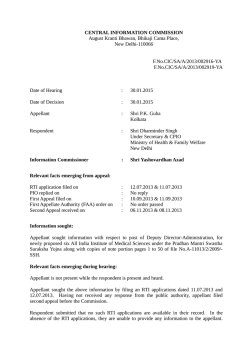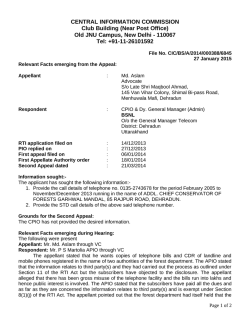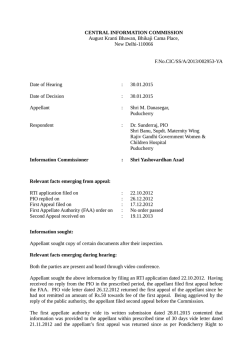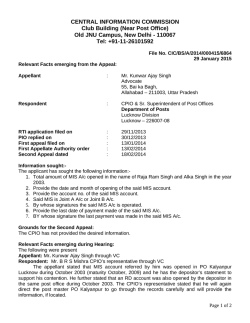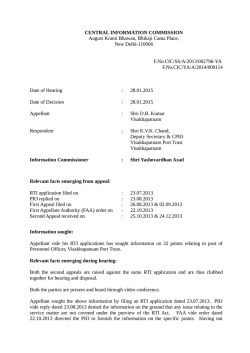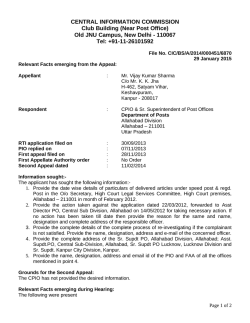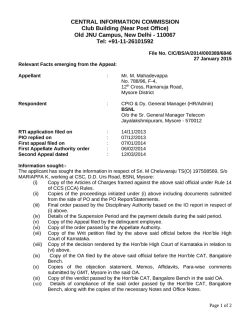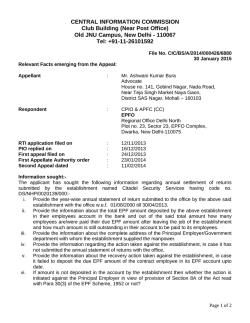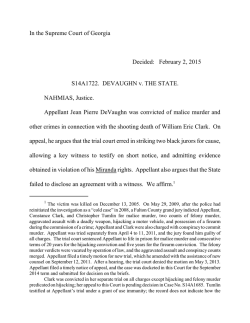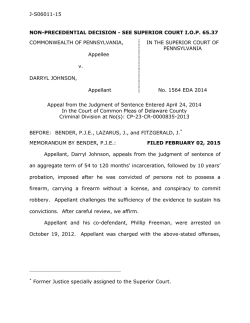
j-s06013-15 non-precedential decision
J-S06013-15 NON-PRECEDENTIAL DECISION - SEE SUPERIOR COURT I.O.P. 65.37 COMMONWEALTH OF PENNSYLVANIA, IN THE SUPERIOR COURT OF PENNSYLVANIA Appellee v. STANLEY BOWENS, Appellant No. 34 EDA 2014 Appeal from the Judgment of Sentence Entered November 25, 2013 In the Court of Common Pleas of Delaware County Criminal Division at No(s): CP-23-CR-0003013-2013 BEFORE: BENDER, P.J.E., LAZARUS, J., and FITZGERALD, J.* MEMORANDUM BY BENDER, P.J.E.: FILED FEBRUARY 02, 2015 Appellant, Stanley Bowens, appeals from the judgment of sentence of an aggregate term of 123 to 246 months’ incarceration, imposed after he was convicted of robbery, criminal conspiracy, and possessing an instrument of crime. After careful review, we vacate Appellant’s judgment of sentence and remand for resentencing. The trial court set forth the facts and procedural history of this case as follows: On October 17, 2012, high school student [Z.K.], who was walking along East 7th Street near its intersection with Ashland Avenue, was approached by three black males. He later testified that two of them were wearing gray hooded sweatshirts, and the other one was wearing a dark hooded sweatshirt. During the encounter, the tallest man, who was wearing a gray hooded ____________________________________________ * Former Justice specially assigned to the Superior Court. J-S06013-15 sweatshirt, pointed a gun at [Z.K.’s] chest while they all told him to empty his pockets. After [Z.K.] advised that he had nothing in his pockets, one of the three males searched him. Satisfied that [Z.K.] had nothing of any value, the three men walked away. [Z.K.] went home and recounted the incident to his grandmother, who telephoned the police. Officer Michael McNamee came to his house and, after taking a statement, set off in search of the three suspects. Later that day, another officer arrived at [Z.K.’s] house and took him several blocks away to a location at which the suspects were being held. [Z.K.] identified the suspects as the individuals who attempted to rob him. A police officer then took [Z.K.] home. Officer McNamee later testified at a suppression hearing that after speaking with [Z.K.], he observed three black males in the 900 block of Ashland Avenue. Two of them were wearing gray hooded sweatshirts, and the third was wearing a black hooded sweatshirt. Their clothing and race matched the description given by the victim. As soon as they turned onto 10th [Street], they began to run away. McNamee was able to stop them in the 1300 block of 10th Street. Immediately upon approaching them, he asked if any had weapons on them. The tall slender male in the gray hooded sweatshirt, later identified as [Appellant], … answered in the affirmative, admitting that he had an “air soft” gun. Officer McNamee removed the gun from [Appellant’s] person. After the victim identified the three men as his assailants, all were placed under arrest. At trial, Andre Woods, one of the three men, admitted that he, [Appellant], and Jonathan Smith attempted to rob the victim. According to his account, [Appellant] pulled out the gun and held it to the victim’s chest. Jonathan Smith patted down the victim’s pockets. Jonathan Smith testified that [Appellant] “flashed” a gun at the victim while Andre Woods checked the victim’s pockets. He was the lookout. After hearing all the testimony, the jury found [Appellant] guilty of: (Count 1) robbery by threatening [Z.K.] or intentionally putting him in fear of immediate serious bodily injury (18 Pa.C.S. § 3701(a)(1)(ii)); (Count 4) criminal conspiracy to commit robbery (18 Pa.C.S. § 903); and (Count 9) possessing an instrument of crime (18 Pa.C.S. § 907(b)). In -2- J-S06013-15 response to the question, “on or about October 17, 2012 did [Appellant] visibly possess a firearm or a replica of a firearm, whether or not the firearm was loaded, that placed the victim in reasonable fear of death or serious bodily injury during the commission of the offense?” The jury responded “yes.” On November 25, 2013, this Court sentenced [Appellant] to a term of confinement of 60-120 months on Count 1; 60-120 months on Count 4, consecutive to Count 1; and 3-6 months on [C]ount 9, consecutive to [C]ounts 1 and 4. Trial Court Opinion (TCO), 4/10/14, at 1-3 (citations to the record omitted). Appellant filed a timely notice of appeal, as well as a timely Pa.R.A.P. 1925(b) concise statement of errors complained of on appeal. Herein, he raises two issues for our review: 1. Did the [trial] [c]ourt … error [sic] by denying Appellant’s motion to suppress? 2. Did the … [trial] [c]ourt error [sic] in imposing a minimum mandatory sentence? Appellant’s Brief at 2. In Appellant’s first issue, he challenges the trial court’s denial of his pretrial motion to suppress. Our standard of reviewing the denial of a suppression motion is as follows: In reviewing an order from a suppression court, we consider the Commonwealth’s evidence, and only so much of the defendant’s evidence as remains uncontradicted. We accept the suppression court’s factual findings which are supported by the evidence and reverse only when the court draws erroneous conclusions from those facts. Commonwealth v. Hoopes, 722 A.2d 172, 174-75 (Pa. Super. 1998). Appellant avers that the court should have granted his motion to suppress because Officer McNamee did not have reasonable suspicion to -3- J-S06013-15 stop him. Appellant emphasizes that he was not in a high crime area, it was not late at night, the officer admitted that Appellant was not acting nervously, and “[t]he only evidence of evasive behavior was that [A]ppellant proceeded to run when [Officer] McNamee began to follow in his police vehicle.” Appellant’s Brief at 8-9. Appellant maintains, however, that “flight alone does not form the basis for reasonable suspicion.” Id. at 9 (citing Commonwealth v. Cook, 735 A.2d 673, 677 (Pa. 1999)). Appellant also argues that the description provided by the victim was very general, and “nothing in the record … suggest[ed] that [A]ppellant matched the description of the robbery suspect[,] other than having a grey hooded sweatshirt[,]” which is not an uncommon or unusual article of clothing to wear “in the middle of October….” Id. Therefore, Appellant contends that Officer McNamee did not possess “reasonable articulable suspicion to detain [him].” Id. at 10. We disagree. At the pretrial suppression hearing, Officer McNamee testified that he responded to a report of a robbery and spoke with the victim, Z.K. N.T., 8/2713, at 12. Z.K. provided the following description of his assailants: [Officer McNamee:] They were three black males in their late teens. One was a taller[,] slimmer male wearing a grey sweatshirt. The other male was average build wearing a grey sweatshirt. And the third [male] was wearing a dark sweatshirt, average build. -4- J-S06013-15 Id. at 13. Officer McNamee testified that according to Z.K., the robbery occurred a few minutes before the officer arrived. Id. Accordingly, Officer McNamee “began to check the area for subjects matching the description.” Id. Between five to ten minutes after the robbery occurred, Officer McNamee “observed three black males” on Ashland Avenue. Id. at 13. The three men were approximately four blocks away from the location of the robbery. Id. at 14. “Two of the black males had grey sweatshirts and the third had a black sweatshirt, which was consistent with the description that was provided” by the victim. Id. at 13-14. Officer McNamee also testified that the three men were young, one of the men was wearing a grey sweatshirt had a “tall, slim build[,]” and the “other two were about average build, average height.” Id. at 15. The officer testified that when he saw the three young men, “[t]hey were walking towards [him] as [he] went past them.”1 Id. at 14. Officer McNamee indicated that the men “were within feet” of the officer’s vehicle when they passed. Id. at 29. Officer McNamee stated: “I went to the end of the block to turn around. As I did that I observed [the three men] turn on 10th Street and they started to run as they made the turn onto 10th Street.” Id. The officer testified that because the ____________________________________________ 1 We note that Officer McNamee testified that he was in full uniform and “was driving an unmarked blue Ford Explorer, which had visible lights on the front.” Id. at 11. The Officer explained that “[t]here are several lights on the front of the vehicle that make it very noticeable.” Id. -5- J-S06013-15 three men’s “clothing …, their age, and their race matched” the description provided by the victim, and because the men ran from him, he believed that they were the individuals involved in the robbery. Id. at 15-16. Accordingly, the officer pursued the three fleeing men, eventually stopping them on 10th Street. Id. at 19-20. Officer McNamee asked the men “if they had any weapons on them[,]” at which point Appellant “stated that he had an air[]soft gun … in the pocket of his hooded sweatshirt.” Id. at 20. The officer then removed the gun from Appellant’s person. Id. After the victim identified the three men as the individuals who robbed him, Appellant and his two cohorts were placed under arrest. Id. at 21. Based on Officer McNamee’s testimony, we ascertain nothing unlawful about the stop of Appellant and his cohorts. It is well-settled that police officers may “detain individuals for a brief investigation when they possess reasonable suspicion that criminal activity is afoot.” Commonwealth v. Brown, 996 A.2d 473, 476-477 (Pa. 2010) (citations omitted). Reasonable suspicion is a less stringent standard than probable cause necessary to effectuate a warrantless arrest, and depends on the information possessed by police and its degree of reliability in the totality of the circumstances. In order to justify the seizure, a police officer must be able to point to “specific and articulable facts” leading him to suspect criminal activity is afoot. In assessing the totality of the circumstances, courts must also afford due weight to the specific, reasonable inferences drawn from the facts in light of the officer's experience and acknowledge that innocent facts, when considered collectively, may permit the investigative detention. Id. at 477 (internal citations omitted). -6- J-S06013-15 Here, based on Officer McNamee’s testimony, we conclude that he did possess reasonable suspicion to pursue and detain Appellant and his cohorts. Initially, while Appellant is correct that nothing in the record suggests he was stopped in a high crime area late at night, and that flight alone does not provide reasonable suspicion, he completely disregards the other circumstances – in addition to his flight - which supported Officer McNamee’s belief that Appellant and his cohorts were the individuals who robbed the victim. Namely, Appellant and his companions were spotted four blocks away from the location of the robbery approximately 10 minutes after the crime occurred. The three young men’s clothing, race, age, and physical builds matched the description provided by the victim. These facts, coupled with Appellant’s flight upon seeing Officer McNamee, made it reasonable for the officer to suspect that Appellant and his companions were the individuals who robbed the victim. Therefore, the trial court did not err in concluding that the stop of Appellant was lawful. Appellant next avers that his mandatory term of five to ten years’ incarceration, imposed pursuant to 42 Pa.C.S. § 9712,2 is illegal under ____________________________________________ 2 That mandatory sentencing statute states, in pertinent part: (a) Mandatory sentence.--Except as provided under section 9716 (relating to two or more mandatory minimum sentences applicable), any person who is convicted in any court of this Commonwealth of a crime of violence as defined in section 9714(g) (relating to sentences for second and subsequent offenses), shall, if the person visibly possessed a firearm or a (Footnote Continued Next Page) -7- J-S06013-15 Alleyne v. U.S., 133 S.Ct. 2151 (2013), Commonwealth v. Newman, 99 A.3d 86 (Pa. Super. 2014) (en banc), and Commonwealth v. Valentine, 101 A.3d 801 (Pa. Super. 2014). We agree. In Alleyne, the United States Supreme Court held that “[a]ny fact that, by law, increases the penalty for a crime is an ‘element’ that must be submitted to the jury and found beyond a reasonable doubt.” Alleyne, 133 S.Ct. at 2155. Based on Alleyne, an en banc panel of this Court declared in Newman that 42 Pa.C.S. § 9712.1 is unconstitutional, as that statute “permits the trial court, as opposed to the jury, to increase a (Footnote Continued) _______________________ replica of a firearm, whether or not the firearm or replica was loaded or functional, that placed the victim in reasonable fear of death or serious bodily injury, during the commission of the offense, be sentenced to a minimum sentence of at least five years of total confinement notwithstanding any other provision of this title or other statute to the contrary. Such persons shall not be eligible for parole, probation, work release or furlough. (b) Proof at sentencing.--Provisions of this section shall not be an element of the crime and notice thereof to the defendant shall not be required prior to conviction, but reasonable notice of the Commonwealth's intention to proceed under this section shall be provided after conviction and before sentencing. The applicability of this section shall be determined at sentencing. The court shall consider any evidence presented at trial and shall afford the Commonwealth and the defendant an opportunity to present any necessary additional evidence and shall determine, by a preponderance of the evidence, if this section is applicable. 42 Pa.C.S. § 9712(a), (b). -8- J-S06013-15 defendant’s minimum sentence based upon a preponderance of the evidence that the defendant was dealing drugs and possessed a firearm, or that a firearm was in close proximity to the drugs.” Newman, 99 A.3d at 98. The Newman Court also held that section 9712.1(c), which mandates that the sentencing court determine the applicability of the statute by a ‘preponderance of the evidence’ standard, is not severable from the remainder of section 9712.1, thus making the entire statute unconstitutional. Id. at 101. Recently, a panel of this Court in Valentine assessed the constitutionality of the same mandatory minimum sentencing statute under which Appellant was sentenced in the present case, 42 Pa.C.S. § 9712. Ultimately, we held that under Alleyne and Newman, section 9712(b) (which mirrors the language of section 9712.1(c)) is invalid and cannot be severed from the remainder of section 9712. Valentine, 101 A.3d at 809, 812. Accordingly, we declared that section 9712 is “unconstitutional as a whole.” Id. at 812.3 ____________________________________________ 3 The Valentine Court also rejected the type of procedure utilized by the trial court in the present case in an attempt to satisfy the dictates of Alleyne. In Valentine, as in this case, the trial court “permitted the jury, on the verdict slip, to determine beyond a reasonable doubt whether [Valentine] possessed a firearm that placed the victim in fear of immediate serious bodily injury in the course of committing a [violent offense] for purposes of the mandatory minimum sentencing provisions of 42 Pa.C.S. § 9712(a)….” Valentine, 101 A.3d at 811. We held that in presenting this question to the jury, “the trial court performed an impermissible legislative (Footnote Continued Next Page) -9- J-S06013-15 In light of Alleyne, Newman, and Valentine, it is clear that 42 Pa.C.S. § 9712 is unconstitutional, and Appellant’s mandatory sentence under that statute is illegal. Therefore, we vacate Appellant’s judgment of sentence and remand for resentencing. Judgment of sentence vacated. Case remanded for resentencing. Jurisdiction relinquished. Judgment Entered. Joseph D. Seletyn, Esq. Prothonotary Date: 2/2/2015 (Footnote Continued) _______________________ function by creating a new procedure in an effort to impose the mandatory minimum sentences in compliance with Alleyne.” Id. - 10 -
© Copyright 2025
